This is the 700th post on the Kosmos Travel Log! As most readers know, we do not post in real time, so this story is from last year. But wanted to continue sharing our road trip to Yosemite with our friend Cindi.
Sunday, September 27, 2009 – The three of us were up early yesterday to go to Yosemite. The two hour drive up through the Sierra Nevada Mountains was scenic and pretty. When we got to the Yosemite entrance, we were surprised to find out it was volunteer day, and there were a slew of people picking up trash, doing road maintenance, and other similar kinds of tasks in the park.
We were surprised at how long of a drive it was from the entrance to the main village in Yosemite Valley. It probably took at least a half hour. Yosemite National Park is about 760,000 acres, so, as long as the drive was, we still hadn’t driven through even a small fraction of the park. We were also surprised by the amount of traffic on the road.
Here is a view from a hilltop as we are about to ascend into the valley. Cindi and her dog, Sky, are in the photo. One of the things that makes Yosemite special is its unique gigantic rock formations, and in this photo you can see El Capitan to the left and Half Dome to the right. Most of the year there is a stunning waterfall coming over the rocks, too, but at the moment the falls are dry.

As we descended into the valley, we saw that this is no remote paradise. The valley was totally built up, with many hotels and permanent housing for the people who work there, and enough amenities to almost call it a “real” small town. Christi was surprised by this, despite the fact that she knew Yosemite is one of the most visited parks in the entire world. But the thing that took all of us by surprise was how darn crowded it was. There were massive amounts of people around. We had expected it to be kind of empty since the official tourist season was over.
Our original plan had been to spend the entire day hiking from the valley up into the mountains. But it was unbelievably hot, in the mid-90’s (Fahrenheit), and we quickly realized that a strenuous hike on a day like today was not a good idea. Christi and Eric decided to take a two hour tram tour of the valley. Since Sky couldn’t go on the tram, Cindi decided to take Sky for a walk through the meadows. Cindi figured staying on flat ground wouldn’t be too strenuous.
The tram tour was interesting. The tram made three stops where we got out and walked around, but most of the time was spent driving very slowly around the valley. The tour guide offered a lot of information that was different from what we had expected. Eric was fascinated by the trams themselves, which are brand new hybrid-diesel trucks. You can kind of see the truck in this photo, and the background gives you a good sense of what the scenery is like throughout the valley. The rock in the background is Half Dome.
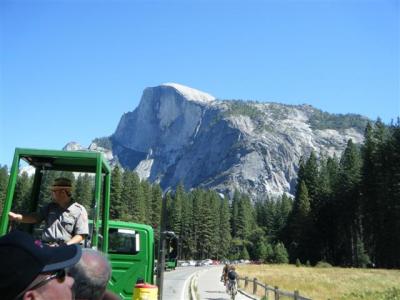
Yosemite Valley is a flood valley with the picturesque Merced River running through it. 30,000 years ago, glaciers cut through the giant rocks and slowly flattened out the floor. While the mountains surrounding the area are chock full of trees, the valley itself is a meadow with many boulders but few trees, which is an especially striking contrast. The soil down here has too much moisture for the trees. The boulders are the debris leftover from the destruction of the giant rocks as the valley was being formed. The giant rocks are still naturally eroding, and “small” chunks of rock fall off the big formations all the time. This is a photo from the first place we stopped. El Capitan is to the left, Sentinel Rock is the back right, and the front right are the Cathedral Rocks.
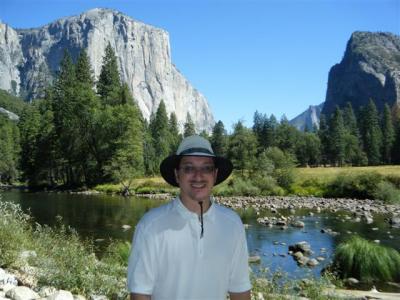
The indigenous people in the area were the Miwok American Indians (Miwok is what white man named them, they call themselves the Ahwahneechee). The Indian legend is that their god told them he was taking them to a new place to live. They went on a long and arduous trek led by this god, with the people not sure where they were going. When they got to this valley, their god told them to stop here, that this was their new home. You can imagine how excited they would be to settle in such a beautiful and bountiful place. The staple of their diet was acorn, and acorns abound here, as did berries, wild animals, and other kinds of foods. They lived peacefully here for thousands of years.
The first white men to ever see the viewpoint pictured above was in March 1851, when a militia group were trying to hunt down some Miwoks who were suspected of attacking a trading post. Entrepreneurs quickly set out to profit from this naturally beautiful location. One example of entrepreneurship was the construction of a private toll road. The road was so narrow that only one coach could fit on the road at a time. If two coaches met head on, one of the coaches would have to be disassembled, moved in pieces around the other coach, and reassembled. The Indians were forcibly removed to a nearby Indian reservation.
Meanwhile, a man named Galen Clark was diagnosed with tuberculosis and told he would die very soon. He decided to spend the last of his days in isolation, living off the land in the Sierra Nevadas. He befriended the Miwoks, who showed him survival skills. In 1857, he found a grove of giant redwood trees located relatively close to Yosemite Valley, which he named Mariposa Grove. Clark made the grove publicly known, and went on a campaign to protect the amazing trees from the logging industry that was destroying nearby forests. Abraham Lincoln signed a law to protect the Mariposa Grove, making it the very first piece of land protected by the federal government. Many consider this act the genesis of the United States national park system. Clark became the first official park guardian. He lived to be 96.
In 1890, Yosemite Valley became the country’s second official national park (Yellowstone was the first). Under President Teddy Roosevelt (who, while camping there, said “Yosemite is the most beautiful place on earth”), the national park was enlarged to include Mariposa Grove, two other sequoia groves, and a substantial amount of additional land surrounding the valley. Conservationists understood that in order to protect the valley, the park needed to include the water tables and areas where the wildlife lived, so Roosevelt made a huge buffer zone around the valley to ensure adequate protection.
El Capitan is a 3,000 foot tall vertical rock with a sheer granite face, and is very popular with rock climbers. At first it was believed impossible to climb, and in 1958, that theory was proved wrong. It took the climbers 47 days. Now, thanks to established routes and modern day equipment, it takes the average climber 3 – 5 days to scale the wall. The people doing the climbing carry sleeping ledges with them that clip onto the rock face (and they wear a harness while sleeping) and go to the bathroom in containers. The record for fastest climb is 2 hours and 37 minutes. It kind of blows our mind how something that takes one person 5 days takes another person 2 ½ hours. Unbelievable!
The tram stopped for a few minutes in front of El Capitan’s face and we looked for the climbers. Compared to the enormity of the rock, the people looked like itty bitty specks and were difficult to see. We know it was a big rock, but seeing how tiny the people looked made it hit home as to just how darn big that rock is. Can you see the many people on the rock?
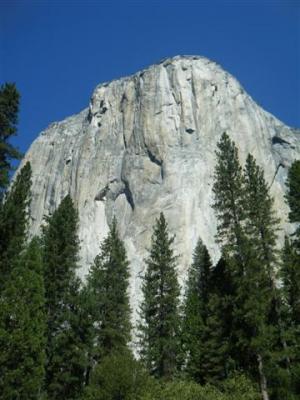
The valley is a flood valley with cyclic severe flooding occurring every 100 years. Most of the construction in the park is inside the valley, so, needless to say, when the flood struck in 1997 and engulfed the valley in 6 feet of water, it was devastating. The rangers were surprised when, after the floods, the plants were invigorated. They realized the water brought nutrient rich sediment with it, which fertilized the soil. That comment reminded us of Egypt. Before they built the dam, the Nile flooded every year, bringing fertile soil with it. Since the dam was built and flooding no longer occurs, the Egyptians now have to use fertilizers.
After the tour, we met up with Cindi. She said the walk through the meadow killed her in the oppressive heat. We went over to the visitor’s center, which has a couple museums and a movie about Yosemite. One museum is the Miwoks, the other about the park. The museums were quite interesting and well done, but at that point we were already on information overload so we didn’t absorb much. We watched the movie about Yosemite, which was a short historical overview with absolutely beautiful imagery.
We got back in the car and drove over to the Mariposa Grove, which is near the entrance to the park. By now, it had finally cooled down enough to go on our hike. Unfortunately, since the sun would be setting relatively soon, we couldn’t pick a long trail, so we chose a four mile loop through the sequoias.
Sequoias, also known as Coast Redwoods, are a species of the Cypress family and an evergreen. They get to be as tall as 115.5 m (379.1 ft) in height and 8 m (26 ft) in diameter. The bark alone is 1 2 feet thick. They are literally the largest living things on Earth. And, they live up to 3,000 years, making them one of the oldest living species, too. The first picture is Eric standing next to a cross section of a Sequoia trunk. You can see it is wider than he is tall. The second picture is Eric and Cindi standing next to a Sequoia, which gives a good perspective on just how enormous they really are. The third is a shot of the top of the same tree, just so you can see what they look like.
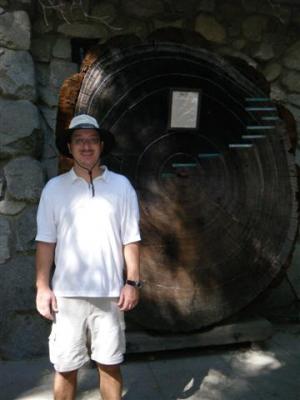
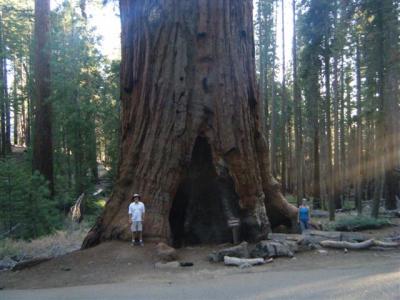

As part of a publicity stunt, in 1895, the park hollowed out holes in the center of a couple of the trees. One of the holes was 8 feet wide and had an actual road running through it. 75 years later, it fell over. But the second one, the California Tunnel Tree, still stands.
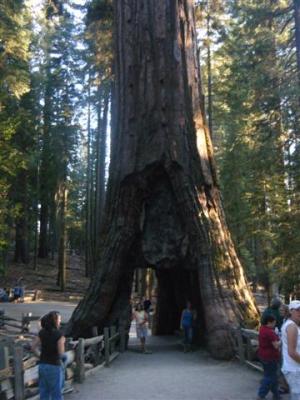
This tree was already fallen over when Galen Clark found the grove, and 150 years later looks much the same as it did when Clark saw it. These trees resist decay for 20 centuries!
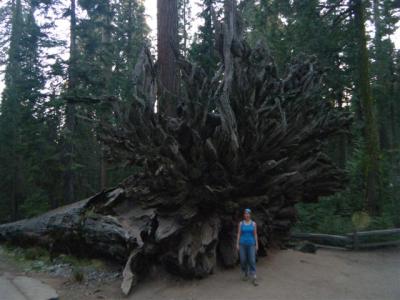
The hike was really nice. It felt good to stretch our legs and enjoy the fresh air and pretty scenery. When the sun got low in the sky, we drove back down the mountains to Fresno. We were all tired from the long day and had a quiet night.
This morning we got Chinese massages in Fresno before heading back to San Diego. We figured a relaxing massage would make the drive home more pleasant. Christi opted for foot reflexology, which actually felt good. The only other time we had tried it in Melaka, it had hurt like heck. Eric got a back rub and loved it. The drive home was uneventful.

See Christy,
I feared this would happen to your blog. You mentioned the F word, and now no one will admit they read your blog and post comments. Please don’t ever go to the F place, mention the F place, or even think about the F place ever again!! 🙂
See you guys at Trawler Fest!